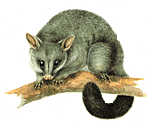Mistletoes - cryptic mimicry
Palatibility and vegetative concealment from herbivores
A biotic factor possibly involved in the selective process is vegetative concealment from herbivores, but which herbivores? Australian mistletoes are food plants for many insects, especially the highly specific caterpillars of the butterfly genera Delias and Ogyris, but mimicry is unlikely to have evolved in response to insect grazing pressure. Insects generally use chemical rather than visual cues for locating food plants, and are clearly successful feeders on mimicking mistletoes.
Mimicry in Australian mistletoes may be better explained on the premise that it provides concealment from herbivorous vertebrates. There are reports worldwide of mistletoes being palatable food plants, even for humans. In Australia it was found that camels preferred mistletoe fodder to the host. In Australia and South Africa mistletoe is used for stock fodder during drought. Presumably mistletoes, with their fleshy leaves and apparent lack of toxins, are generally palatable to a wide range of herbivores, and in Australian woodlands may be more palatable than their dry, hard-leaved, relatively undigestible hosts.
Which herbivores? The Australian fauna includes many species which feed on foliage. Kangaroos and wallabies account for more than half our herbivore species, but can be eliminated because they are normally grazers and are almost all terrestrial. Among arborial marsupials, the koala and greater glider are highly specialized feeders utilizing only a few species of eucalypts, and apparently rarely if ever eat mistletoe. The remaining arboreal herbivores are mostly possums and gliders, and although some are blossom feeders, and some are omnivorous, many are well known as feeders on foliage. Most notable are the ringtails (Pseudocheirus) and the common brush-tailed possum (Trichosurus). These are most likely to have been significant predators on mistletoe. Being nocturnal, but with excellent vision, possums presumably cue initially on leaf shape, which is the more precisely copied feature of mistletoe mimicry. Controlled feeding experiments with captive possums indicate that possums prefer mistletoe leaves and fruits to Eucalyptus leaves, although they appear to periodically switch from one to the other, possibly as a consequence of feeding depression.
|
There is considerable anecdotal evidence to support the contention that the common possum is a major predator of Australian mistletoes. There appears to have been a general increase in mistletoe abundance early in the twentieth century. Habitat disturbance, uncontrolled hunting and extermination of possums have been correlated with increased survival of mistletoe. Conversely, there are several reports that possums, which have been introduced into New Zealand, are responsible for recent dramatic decreases in certain mistletoe populations there. None of the relatively primitive New Zealand loranths can be regarded as mimics, although some are relatively specific for Nothofagus as host. Possum predation is blamed for the apparent extinction of Trilepidea adamsii, a mistletoe which originally had a restricted distribution in North Island.
It has therefore been argued that there has been a significant interaction (predation) between some Australian herbivores (notably possums) and the Loranthaceae of the region, and that the similarity between many of the mistletoes and their hosts is a genuine protective mimicry which has evolved in response to this predation pressure.
See another suggestion: The bird search image hypothesis
![An Australian Government Initiative [logo]](/images/austgovt_brown_90px.gif)



